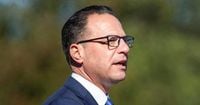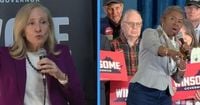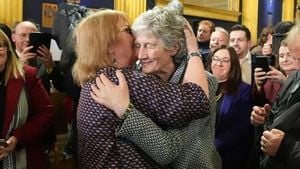As Virginians prepare to head to the polls on November 4, 2025, the state stands on the cusp of a historic moment: for the first time, voters will elect a woman as governor. The two contenders—Democrat Abigail Spanberger and Republican Winsome Earle-Sears—offer sharply contrasting visions for Virginia’s future, and the outcome is being closely watched not just for its local significance, but for what it might signal about the nation’s political direction after Donald Trump’s return to the White House.
Abigail Spanberger, a former CIA officer and three-term Congresswoman, has built her campaign around a moderate, kitchen-table approach to governance. As reported by USA TODAY, she’s been described as a “poised policy-wonk” who eschews the bombast that often characterizes modern political campaigns. Instead, she emphasizes pragmatism, bipartisanship, and her record in the bipartisan Problem Solvers Caucus. In her words: “When Trump’s DOGE fired thousands of Virginians, my opponent... defended it. Trump is now threatening DOGE 2.0 and she’s again defending it. Now is the time to stand up for Virginia jobs—not encourage more mass layoffs.”
Spanberger’s opponent, Winsome Earle-Sears, is the state’s current lieutenant governor and a Marine Corps veteran. Earle-Sears has focused her campaign on traditional conservative themes, including support for business, tougher immigration enforcement, and opposition to transgender rights in schools. Her supporters praise her as a pro-business leader who aligns with the values of many Virginians, especially those frustrated with what they see as heavy-handed federal intervention from Washington.
But if the campaign trails are any indication, the energy and star power seem to be on Spanberger’s side. According to NBC News, prominent Democrats from across the country have descended on Virginia in the final days of the race. Pennsylvania Governor Josh Shapiro, a potential 2028 presidential contender, campaigned for Spanberger in Portsmouth, calling her a “compassionate,” “caring,” and “well-grounded person” who would act as a “freedom fighter” in the face of what he described as attacks on states’ rights and personal freedoms by President Trump. “She’s going to protect your fundamental freedoms. That’s where governors matter most,” Shapiro declared to a raucous crowd.
Spanberger has also been joined by former Transportation Secretary Pete Buttigieg, Kentucky Governor Andy Beshear, Senator Ruben Gallego, and, soon, former President Barack Obama. This parade of national Democrats underscores how much is at stake for the party in Virginia, one of only two states holding a gubernatorial election this year. As Shapiro put it, “This is our moment to capture freedom and capture light from the darkness that is coming from other areas. Now is a moment, Virginia, where the nation is watching you to see whether or not we’re going to give our kids a shot, whether or not we’re going to protect our fundamental freedoms.”
Republicans, meanwhile, have struggled to match that level of outside support. Earle-Sears has been joined by former Virginia Governor Bob McDonnell and a handful of national Republicans, including Rep. Byron Donalds and Senator Ted Cruz. But Donald Trump himself has not formally endorsed Earle-Sears, nor has he appeared with her on the campaign trail—an absence that some GOP strategists see as a missed opportunity in a state that has become increasingly competitive. Earle-Sears, when pressed by reporters, pointed to the support she’s received from Donalds and Cruz, but declined to name any other big-name Republicans scheduled to campaign with her in the race’s closing days.
Polling consistently shows Spanberger with a lead over Earle-Sears. A recent Virginia Commonwealth University poll cited by USA TODAY found Spanberger ahead by roughly 7%. Other surveys have given her an even larger margin. The gap in fundraising between the two campaigns reflects this polling advantage, with Spanberger consistently outraising her opponent.
The issues dominating the race reflect both local concerns and national anxieties. The economy looms large, especially after the Trump administration’s Department of Government Efficiency (DOGE) implemented layoffs that hit Virginia’s large population of federal workers particularly hard. According to a survey by Public Policy Polling, 46% of Virginia voters blamed Trump and congressional Republicans for the ongoing federal government shutdown, compared to 37% who faulted Democrats. Spanberger has made these layoffs a centerpiece of her campaign, arguing that Earle-Sears failed to stand up for Virginia workers when it mattered most.
Education, too, has become a flashpoint. The two candidates have staked out opposing positions on issues like transgender rights in schools, with Earle-Sears taking a more conservative stance that appeals to her base but has drawn criticism from progressives and moderates alike. The business climate is another area of contention. Spanberger is seen by many as supportive of innovation and workforce development, while Earle-Sears touts a more traditional, pro-business agenda.
Virginia’s unique political history adds another layer of intrigue to the contest. The state has a tradition of electing governors from the party opposite the sitting president, with only one exception since the 1970s. That historical pattern, combined with the state’s evolving demographics and the national political climate, makes this year’s race especially unpredictable.
Yet, for all the focus on policy and party alignment, the race has also been marked by personal attacks and controversies. Earle-Sears has sought to put Spanberger on the defensive by pressing her about her support for Democratic attorney general nominee Jay Jones, who became embroiled in scandal following the release of controversial text messages. During their debate, Earle-Sears challenged Spanberger directly: “You have little girls. What would it take? Him pulling the trigger? Is that what would do it and then you would say he needs to get out of the race, Abigail?” Spanberger condemned the remarks but stopped short of calling for Jones to exit the race, a move that some see as cautious and others as evasive.
Despite these attacks, Spanberger’s measured, on-message style has helped her maintain her lead. Critics on the right, such as conservative Virginia radio host John Fredericks, have labeled her “soulless, emotionless, disconnected and failing to stand on principle.” But supporters argue that her steady approach is exactly what’s needed in a time of political volatility.
As Election Day approaches, both campaigns are ramping up their efforts. Spanberger’s team is betting that her moderate platform, national security credentials, and focus on protecting federal workers will resonate with voters weary of partisan bickering and economic uncertainty. Earle-Sears, meanwhile, is hoping that late-breaking controversies and concerns about Democratic leadership will energize her supporters and close the gap.
Whatever the outcome, the 2025 Virginia gubernatorial race is set to make history—not just for breaking the glass ceiling, but for offering a revealing snapshot of a state, and a country, at a political crossroads.





